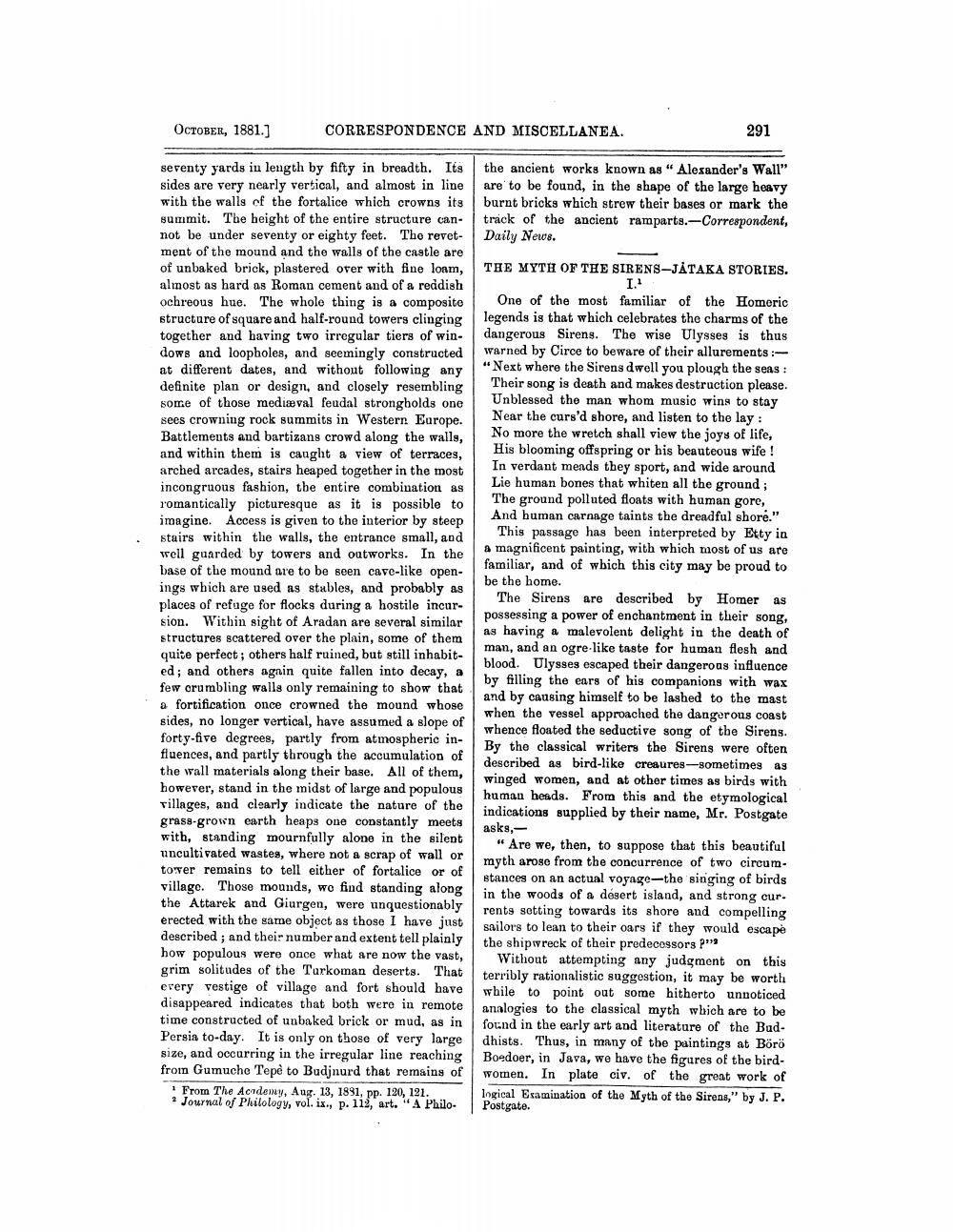________________
OCTOBER, 1881.]
CORRESPONDENCE AND MISCELLANEA.
291
the ancient works known as "Alexander's Wall" are to be found, in the shape of the large heavy burnt bricks which strew their bages or mark the track of the ancient ramparts.---Correspondent, Daily News.
seventy yards in length by fifty in breadth. Its sides are very nearly vertical, and almost in line with the walls of the fortalice which crowns its summit. The height of the entire structure cannot be under seventy or eighty feet. The revetment of the mound and the walls of the castle are of unbaked brick, plastered over with fine loam, almost as hard as Roman cement and of a reddish ochreous hue. The whole thing is a composite structure of square and half-round towers clinging together and having two irregular tiers of windows and loopholes, and seemingly constructed at different dates, and without following any definite plan or design, and closely resembling some of those mediæval feudal strongholds one sees crowning rock summits in Western Europe. Battlements and bartizans crowd along the walls, and within them is caught a view of terraces, arched arcades, stairs heaped together in the most incongruous fashion, the entire combination as romantically picturesque as it is possible to imagine. Access is given to the interior by steep stairs within the walls, the entrance small, and well guarded by towers and outworks. In the base of the mound are to be seen cave-like openings which are used as stables, and probably as places of refuge for flocks during a hostile incursion. Within sight of Aradan are several similar structures scattered over the plain, some of them quite perfect; others half ruined, but still inhabited; and others agnin quite fallen into decay, a few crumbling walls only remaining to show that a fortification once crowned the mound whose sides, no longer vertical, have assumed a slope of forty-five degrees, partly from atmospheric influences, and partly through the accumulation of the wall materials along their base. All of them, however, stand in the midst of large and populous villages, and clearly indicate the nature of the grass-grown earth heaps one constantly meets with, standing mournfully alone in the silent uncultivated wastes, where not a scrap of wall or tower remains to tell either of fortalice or of village. Those mounds, wo find standing along the Attarek and Giurgen, were unquestionably erected with the same object as those I have just described ; and their number and extent tell plainly how populous were once what are now the vast, grim solitudes of the Tarkoman deserts. That every vestige of village and fort should have disappeared indicates that both were in remote time constructed of unbaked brick or mud, as in Persia to-day. It is only on those of very large size, and occurring in the irregular line reaching from Gumuche Tepe to Budjnurd that remains of
1 From The Academy, Aug. 13, 1891, pp. 120, 121. - Journal of Philology, vol. ix., p. 112, art. "A Philo.
THE MYTH OF THE SIRENS-JÅTAKA STORIES.
I. One of the most familiar of the Homeric legends is that which celebrates the charms of the dangerous Sirens. The wise Ulysses is thus warned by Circe to beware of their allurements:"Next where the Sirens dwell you plough the seas :
Their song is death and makes destruction please. Unblessed the man whom music wins to stay Near the curs'd shore, and listen to the lay : No more the wretch shall view the joys of life, His blooming offspring or his beauteous wife! In verdant mends they sport, and wide around Lie human bones that whiten all the ground; The ground polluted floats with human gore, And human carnage taints the dreadful shore."
This passage has been interpreted by Etty in & magnificent painting, with which most of us are familiar, and of which this city may be proud to be the home.
The Sirens are described by Homer as possessing a power of enchantment in their song, as having a malevolent delight in the death of man, and an ogre.like taste for human flesh and blood. Ulysses escaped their dangerous influence by filling the ears of his companions with wax and by causing himself to be lashed to the mast when the vessel approached the dangerous coast whence floated the seductive song of the Sirens. By the classical writers the Sirens were often described as bird-like crea ures--sometimes as winged women, and at other times as birds with human heads. From this and the etymological indications supplied by their name, Mr. Postgate asks,
"Are we, then, to suppose that this beautiful myth arose from the concurrence of two circumstances on an actual voyage-the singing of birds in the woods of a désert island, and strong cur. rente sotting towards its shore and compelling sailor's to lean to their oars if they would escape the shipwreck of their predecessors ?"
Without attempting any judgment on this terribly rationalistic suggestion, it may be worth while to point out some hitherto unnoticed analogies to the classical myth which are to be found in the early art and literature of the Baddhists. Thus, in many of the paintings at Börö Boedoer, in Java, we have the figures of the birdwomen. In plate civ. of the great work of logical Examination of the Myth of the Sirens," by J. P. Postgate.




